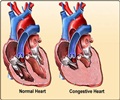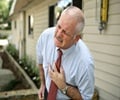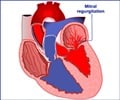
The committee reviewed three large randomized clinical trials of CRT in patients with mild heart failure symptoms, as well as a number of meta-analyses that evaluated the use of CRT regardless of symptom severity. "The totality of the evidence supports the use of CRT in heart failure patients with reduced left ventricular ejection function (LVEF) across the spectrum of mild to severe symptoms," reports senior author Randall C. Starling, MD, MPH, of the Department of Cardiovascular Medicine at the Cleveland Clinic. "The evidence is most compelling among patients with an electrocardiogram QRS duration ≥ 150 ms (normal being <100 ms)."
Specifically, the Guidelines Committee determined that CRT is recommended for patients in sinus rhythm with a widened QRS interval ≥ 150 that is not due to RBBB who have reduced ejection fraction and persistent mild to moderate heart failure, despite optimal medical therapy. CRT may be considered for ambulatory class IV patients with QRS interval ≥ 150 ms and severe LV systolic dysfunction. CRT may also be considered for patients with a QRS interval of ≥ 120 to < 150 ms and severe LV systolic dysfunction, who have persistent mild to severe heart failure, despite optimal medical therapy.
The evidence supporting the QRS thresholds in these recommendations is based primarily on subgroup analyses and systematic reviews rather than on the boundaries of eligibility criteria used in the trial. "Subgroup analyses are generally limited by the potential for chance findings," Dr. Starling notes. "However, the observations that the majority of the benefit exists in the QRS duration ≥ 150 ms subgroup has been a consistent finding across multiple clinical trials, and it has been confirmed in meta-analysis. Therefore, the Guideline Committee agreed that the totality of evidence supported the QRS duration thresholds."
"CRT is still a relatively new technology that seemed to come out of nowhere a few years ago," comments HFSA President, Barry Massie, MD. "However, growing evidence leaves little doubt about the value of this technology. Multiple trials have demonstrated that heart failure patients, whose hearts contract in a discordant manner, have more symptoms and poorer survival. The idea that stimulating the heart electrically to improve its efficiency could have a profound effect was greeted with some skepticism but no longer. Multiple trials have demonstrated that this intervention makes patients feel better, prevents hospitalizations, and prolongs survival in heart failure patients. I congratulate the Guideline Committee for taking on this project, reviewing a wide range of data, and making a compelling argument for increased use of this new technology that has a great deal of promise."
Several evidence gaps must be addressed, including the ideal threshold for QRS duration, QRS morphology, lead placement, degree of myocardial scarring, and the best approach to evaluating dyssynchrony. "It is anticipated that the recommendations will evolve to focus on optimizing patient selection and identifying factors that reliably predict a favorable response to CRT, ideally based on criteria that are clinically important to our patients. We envision that this will form the substrate for guidelines to be updated by the Committee," Dr. Starling concludes.
Advertisement












